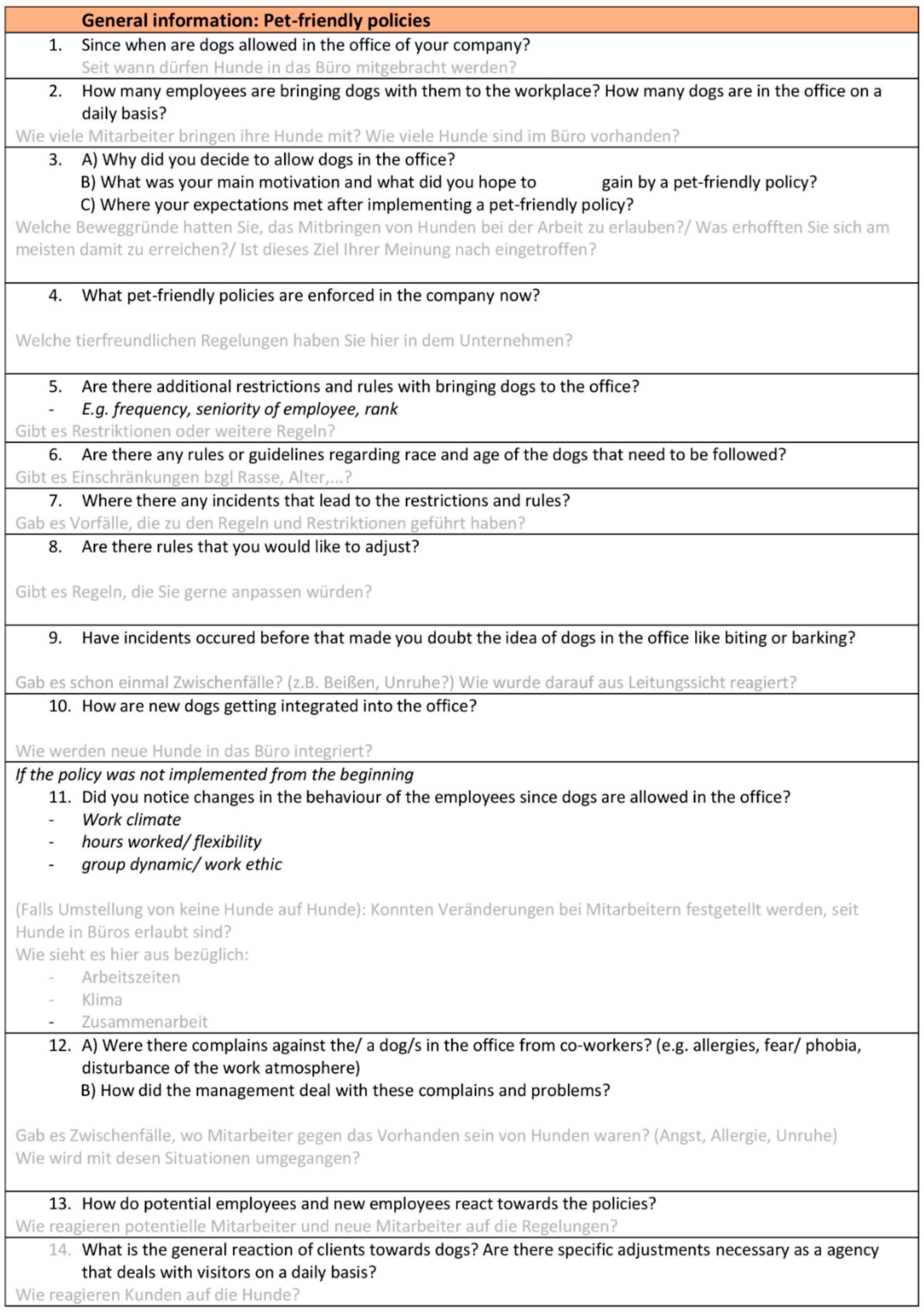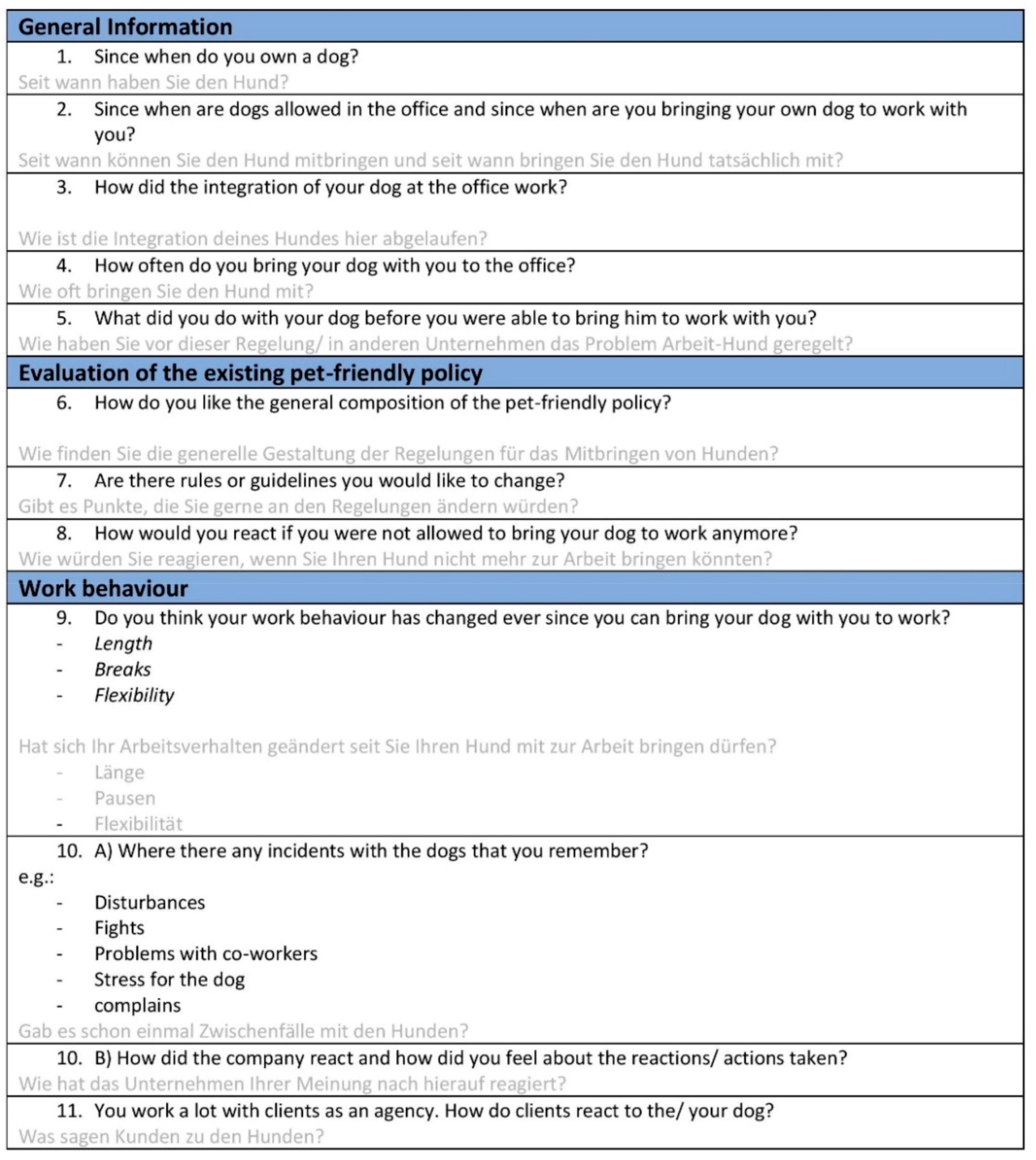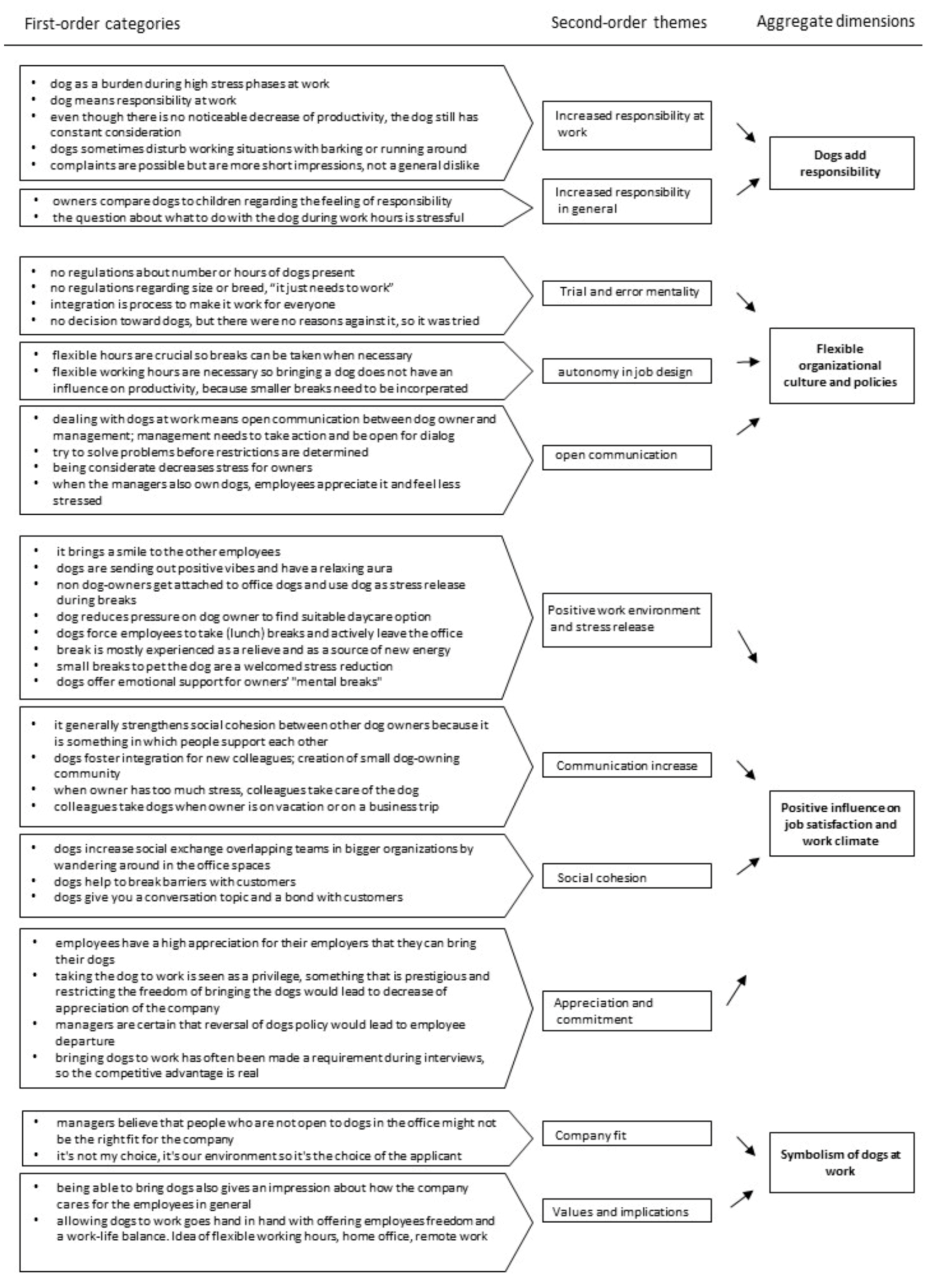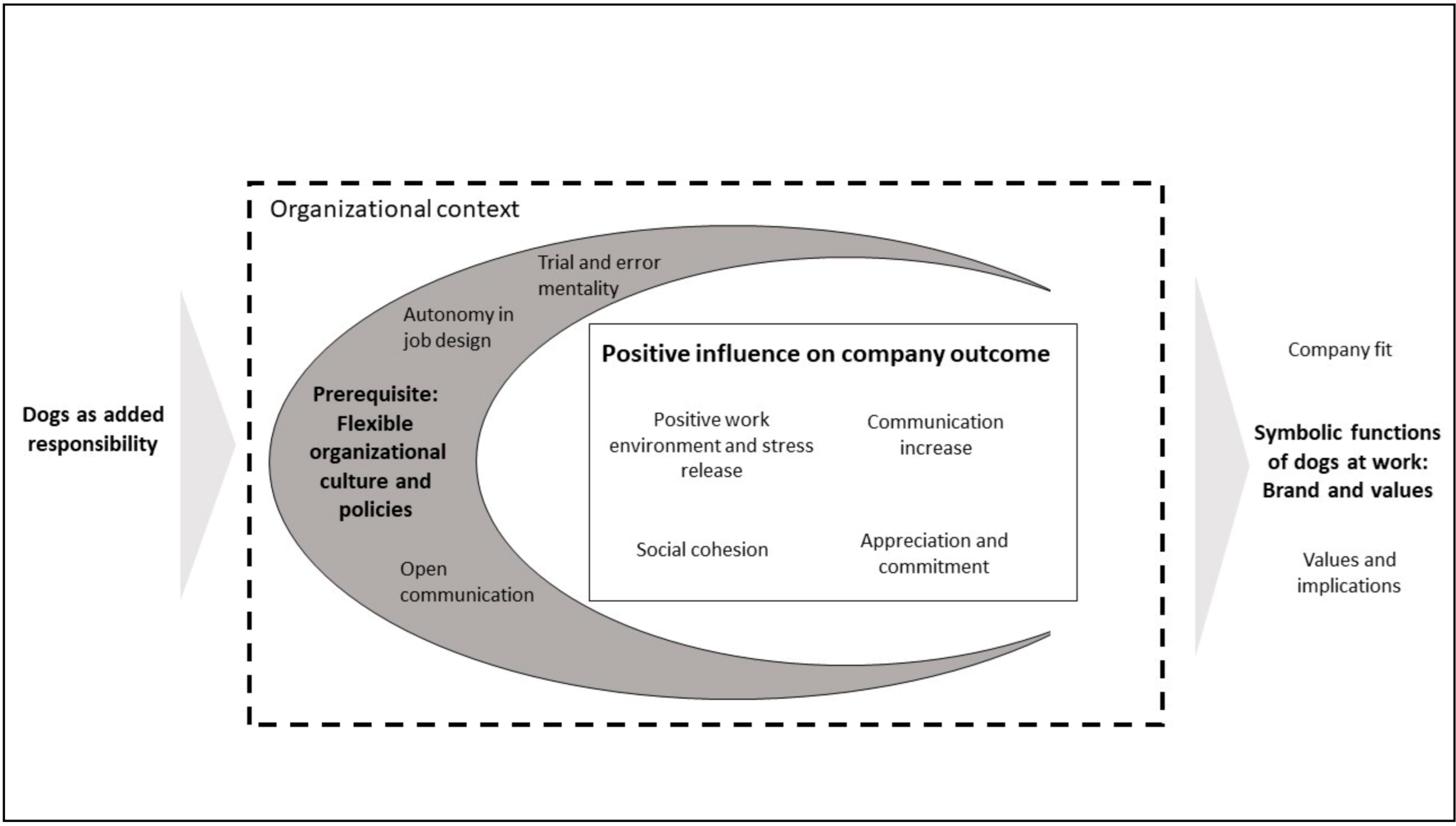Dogs at the Workplace: A Multiple Case Study
Abstract
Simple Summary
Abstract
1. Introduction
2. Theoretical Background
2.1. Dogs and Humans—In General
2.2. Dogs in the Workplace
2.2.1. Interaction and Group Dynamics
2.2.2. Employer Brand
2.3. Risks of Having Dogs at the Workplace
2.3.1. Allergies, Phobias, and Dislikes
2.3.2. Dangers
2.3.3. Distractions
2.4. Limitations of Existing Research
3. Methods
4. Data Analysis
5. Findings
5.1. Flexible Organizational Culture and Policies
5.1.1. Trial-And-Error Mentality
5.1.2. Open Communication
5.1.3. Autonomy in Job Design
5.2. Positive Influence on Job Satisfaction and Climate
5.2.1. Positive Work Environment and Stress Release
So I somehow sit and hack on my laptop and talk on the phone and he comes and then I notice immediately, I take my time, look down at him, cuddle him, take him on my lap, then cuddle him again, and then I recharge my batteries in that moment, which maybe half an hour of break wouldn’t have brought me.
They lead in any case to the fact that at least the dog-owners have to really do a lunch break, that can happen in agencies quite often that one tends to leave out the break if there is too much work at times. […] That was also for me personally one of the motives for having a dog.
I honestly notice that the dog helps her because she goes out with him twice, she goes out twice and that’s sometimes very good and when she comes back with him after 20 min I get the impression that a few knots have loosened in the 20 min and it seems to be the fresh air.
5.2.2. Communication Improvement
[D]ogs definitely contribute to the exchange across the teams because the dogs are such a connecting element. […] so even if I’m only with a team because my dog is running there, or vice versa, that’s just a lot more social exchange in the whole agency.
5.2.3. Social Cohesion
5.2.4. Appreciation and Commitment
5.3. Symbolic Functions of Dogs at Work: Brand and Values
5.3.1. Applicant–Company Fit
[T]hen I would also immediately think, OK if he already starts like that, then he doesn’t fit in here either. That’s just the way it is in agencies, that everything is always very open and relaxed and that’s kind of like that.
5.3.2. Values and Implications
So we want to give our employees as much freedom and entertainment as possible and work-life balance and life-life balance and opportunities, and for me that includes that [being able to bring the dog to work].
5.4. Deriving a Grounded Theoretical Model
6. Discussion
7. Conclusions
Author Contributions
Funding
Institutional Review Board Statement
Informed Consent Statement
Data Availability Statement
Conflicts of Interest
References
- Foreman, A.M.; Glenn, M.K.; Meade, B.J.; Wirth, O. Dogs in the Workplace: A Review of the Benefits and Potential Challenges. Int. J. Environ. Res. Public Health 2017, 14, 498. [Google Scholar] [CrossRef]
- Ayyar, R. Why Pets in the Workplace May Not Be as Great as You Thought. Available online: https://www.fastcompany.com/3038492/why-pets-in-the-workplace-may-not-be-as-great-as-you-thought (accessed on 2 September 2019).
- Dholakiya, P. For a Productive Workplace Let Your Office Go to the Dogs. Available online: https://www.entrepreneur.com/article/237982 (accessed on 2 September 2019).
- Kelemen, T.K.; Matthews, S.H.; Wan, M.; Zhang, Y. The secret life of pets: The intersection of animals and organizational life. J. Organ. Behav. 2020, 41, 694–697. [Google Scholar] [CrossRef]
- Cunha, M.P.e.; Rego, A.; Munro, I. Dogs in organizations. Hum. Relat. 2019, 72, 778–800. [Google Scholar] [CrossRef]
- Sandberg, J.; Alvesson, M. Meanings of Theory: Clarifying Theory through Typification. J. Manag. Stud. 2020, 36, 247. [Google Scholar] [CrossRef]
- Dotson, M.J.; Hyatt, E.M. Understanding dog–human companionship. J. Bus. Res. 2008, 61, 457–466. [Google Scholar] [CrossRef]
- Vormbrock, J.K.; Grossberg, J.M. Cardiovascular effects of human-pet dog interactions. J. Behav. Med. 1988, 11, 509–517. [Google Scholar] [CrossRef] [PubMed]
- Straatman, I.; Hanson, E.K.S.; Endenburg, N.; Mol, J.A. The Influence of a Dog on Male Students During a Stressor. Anthrozoös 1997, 10, 191–197. [Google Scholar] [CrossRef]
- Gee, N.R.; Friedmann, E.; Stendahl, M.; Fisk, A.; Coglitore, V. Heart Rate Variability During a Working Memory Task: Does Touching a Dog or Person Affect the Response? Anthrozoös 2014, 27, 513–528. [Google Scholar] [CrossRef]
- Batson, K.; McCabe, B.; Baun, M.M.; Wilson, C. The Effect of a Therapy Dog on Socialization and Physiological Indicators of Stress in Persons Diagnosed with Alzheimer’s Disease. In Companion Animals in Human Health; Wilson, C.C., Turner, D.C., Eds.; SAGE Publications: Thousand Oaks, CA, USA, 1998; pp. 203–216. ISBN 9780761910626. [Google Scholar]
- Martin, F.; Farnum, J. Animal-assisted therapy for children with pervasive developmental disorders. West. J. Nurs. Res. 2002, 24, 657–670. [Google Scholar] [CrossRef]
- Limond, J.A.; Bradshaw, J.W.S.; Cormack, M.K.F. Behavior of Children with Learning Disabilities Interacting with a Therapy Dog. Anthrozoös 1997, 10, 84–89. [Google Scholar] [CrossRef]
- Smith, B. The ‘pet effect’--health related aspects of companion animal ownership. Aust. Fam. Physician 2012, 41, 439–442. [Google Scholar] [PubMed]
- Lentino, C.; Visek, A.J.; McDonnell, K.; DiPietro, L. Dog walking is associated with a favorable risk profile independent of moderate to high volume of physical activity. J. Phys. Act. Health 2012, 9, 414–420. [Google Scholar] [CrossRef] [PubMed]
- Friedmann, E.; Thomas, S.A.; Son, H. Pets, depression and long term survival in community living patients following myocardial infarction. Anthrozoös 2011, 24, 273–285. [Google Scholar] [CrossRef] [PubMed]
- Raina, P.; Waltner-Toews, D.; Bonnett, B.; Woodward, C.; Abernathy, T. Influence of companion animals on the physical and psychological health of older people: An analysis of a one-year longitudinal study. J. Am. Geriatr. Soc. 1999, 47, 323–329. [Google Scholar] [CrossRef]
- Odendaal, J.S.; Weyers, A. Human companion-animal relationships in the veterinary consulting room. J. S. Afr. Vet. Assoc. 1990, 61, 14–23. [Google Scholar]
- McConnell, A.R.; Brown, C.M.; Shoda, T.M.; Stayton, L.E.; Martin, C.E. Friends with benefits: On the positive consequences of pet ownership. J. Personal. Soc. Psychol. 2011, 101, 1239–1252. [Google Scholar] [CrossRef]
- Allen, K.M.; Blascovich, J.; Tomaka, J.; Kelsey, R.M. Presence of human friends and pet dogs as moderators of autonomic responses to stress in women. J. Personal. Soc. Psychol. 1991, 61, 582–589. [Google Scholar] [CrossRef]
- Polheber, J.P.; Matchock, R.L. The presence of a dog attenuates cortisol and heart rate in the Trier Social Stress Test compared to human friends. J. Behav. Med. 2014, 37, 860–867. [Google Scholar] [CrossRef]
- Odendaal, J.S.J.; Meintjes, R.A. Neurophysiological Correlates of Affiliative Behaviour between Humans and Dogs. Vet. J. 2003, 165, 296–301. [Google Scholar] [CrossRef]
- Miller, S.C.; Kennedy, C.C.; DeVoe, D.C.; Hickey, M.; Nelson, T.; Kogan, L. An Examination of Changes in Oxytocin Levels in Men and Women Before and After Interaction with a Bonded Dog. Anthrozoös 2009, 22, 31–42. [Google Scholar] [CrossRef]
- Foreman, A.M.; Allison, P.; Poland, M.; Meade, B.J.; Wirth, O. Employee Attitudes about the Impact of Visitation Dogs on a College Campus. Anthrozoös 2019, 32, 35–50. [Google Scholar] [CrossRef]
- Ward-Griffin, E.; Klaiber, P.; Collins, H.K.; Owens, R.L.; Coren, S.; Chen, F.S. Petting away pre-exam stress: The effect of therapy dog sessions on student well-being. Stress Health 2018, 34, 468–473. [Google Scholar] [CrossRef]
- Skok, A.; Harvey, D.; Reddihough, D. Perceived stress, perceived social support, and wellbeing among mothers of school-aged children with cerebral palsy. J. Intellect. Dev. Disabil. 2006, 31, 53–57. [Google Scholar] [CrossRef] [PubMed]
- Moeini, B.; Shafii, F.; Hidarnia, A.; Babaii, G.R.; Birashk, B.; Allahverdipour, H. Perceived Stress, Self-Efficacy and Its Relations to Psychological Well-Being Status in Iranian Male High School Students. Soc. Behav. Personal. 2008, 36, 257–266. [Google Scholar] [CrossRef]
- Schiffrin, H.H.; Rezendes, D.; Nelson, S.K. Stressed and Happy? Investigating the Relationship Between Happiness and Perceived Stress. J. Happiness Stud. 2009, 10, 503. [Google Scholar] [CrossRef]
- Anderson, W.P.; Reid, C.M.; Jennings, G.L. Pet ownership and risk factors for cardiovascular disease. Med. J. Aust. 1992, 157, 298–301. [Google Scholar] [CrossRef]
- Friedmann, E.; Katcher, A.H.; Lynch, J.J.; Thomas, S.A. Animal companions and one-year survival of patients after discharge from a coronary care unit. Public Health Rep. 1980, 95, 307–312. [Google Scholar]
- Parslow, R.A.; Jorm, A.F. Pet ownership and risk factors for cardiovascular disease: Another look. Med. J. Aust. 2003, 179, 466–468. [Google Scholar] [CrossRef]
- Potter, K.; Teng, J.E.; Masteller, B.; Rajala, C.; Balzer, L.B. Examining How Dog ‘Acquisition’ Affects Physical Activity and Psychosocial Well-Being: Findings from the Buddy Study Pilot Trial. Animals 2019, 9, 666. [Google Scholar] [CrossRef]
- Westgarth, C.; Christley, R.M.; Jewell, C.; German, A.J.; Boddy, L.M.; Christian, H.E. Dog owners are more likely to meet physical activity guidelines than people without a dog: An investigation of the association between dog ownership and physical activity levels in a UK community. Sci. Rep. 2019, 9, 5704. [Google Scholar] [CrossRef]
- Colarelli, S.M.; McDonald, A.M.; Christensen, M.S.; Honts, C. A Companion Dog Increases Prosocial Behavior in Work Groups. Anthrozoös 2017, 30, 77–89. [Google Scholar] [CrossRef]
- Fick, K.M. The influence of an animal on social interactions of nursing home residents in a group setting. Am. J. Occup. Ther. 1993, 47, 529–534. [Google Scholar] [CrossRef]
- Bulsara, M.; Wood, L.; Giles-Corti, B.; Bosch, D. More Than a Furry Companion: The Ripple Effect of Companion Animals on Neighborhood Interactions and Sense of Community. Soc. Anim. 2007, 15, 43–56. [Google Scholar] [CrossRef]
- McNicholas, J.; Collis, G.M. Dogs as catalysts for social interactions: Robustness of the effect. Br. J. Psychol. 2000, 91 Pt 1, 61–70. [Google Scholar] [CrossRef]
- Hall, S.S.; Mills, D.S. Taking Dogs into the Office: A Novel Strategy for Promoting Work Engagement, Commitment and Quality of Life. Front. Vet. Sci. 2019, 6, 138. [Google Scholar] [CrossRef]
- Yao, S.; Zhao, W.; Geng, Y.; Chen, Y.; Zhao, Z.; Ma, X.; Xu, L.; Becker, B.; Kendrick, K.M. Oxytocin Facilitates Approach Behavior to Positive Social Stimuli via Decreasing Anterior Insula Activity. Int. J. Neuropsychopharmacol. 2018, 21, 918–925. [Google Scholar] [CrossRef]
- Daniels, J. More Firms Allowing Dogs (and Other Pets) in the Office. Available online: https://www.cnbc.com/2015/10/15/more-firms-allowing-dogs-and-other-pets-in-the-office.html (accessed on 2 September 2019).
- Foderaro, L.W. In More Office Cubicles, the Dog Has Its Day. Available online: https://www.nytimes.com/1999/07/06/nyregion/in-more-office-cubicles-the-dog-has-its-day.html (accessed on 2 September 2019).
- Du Plooy, J.; Roodt, G. Work engagement, burnout and related constructs as predictors of turnover intentions. SA J. Ind. Psychol. 2010, 36, 1–13. [Google Scholar] [CrossRef]
- Barker, R.T.; Knisely, J.S.; Barker, S.B.; Cobb, R.K.; Schubert, C.M. Preliminary investigation of employee’s dog presence on stress and organizational perceptions. Int. J. Workplace Health Manag. 2012, 5, 15–30. [Google Scholar] [CrossRef]
- Wells, M.; Perrine, R. Critters in the cube farm: Perceived psychological and organizational effects of pets in the workplace. J. Occup. Health Psychol. 2001, 6, 81–87. [Google Scholar] [CrossRef]
- Norling, A.-Y.; Keeling, L. Owning a Dog and Working: A Telephone Survey of Dog Owners and Employers in Sweden. Anthrozoös 2010, 23, 157–171. [Google Scholar] [CrossRef]
- Barker, R.T. On the Edge or not?: Opportunities for Interdisciplinary Scholars in Business Communication to Focus on the Individual and Organizational Benefits of Companion Animals in the Workplace. J. Bus. Commun. 2005, 42, 299–315. [Google Scholar] [CrossRef]
- Goffee, R.; Jones, G. Creating the Best Workplace on Earth. Available online: https://hbr.org/2013/05/creating-the-best-workplace-on-earth (accessed on 2 September 2019).
- Spiceworks. Available online: https://community.spiceworks.com/blog/2612-secrets-to-happiness-what-factors-influence-job-satisfaction-in-it (accessed on 30 November 2019).
- Rossbach, K.A.; Wilson, J.P. Does a Dog’s Presence Make a Person Appear More Likable?: Two Studies. Anthrozoös 1992, 5, 40–51. [Google Scholar] [CrossRef]
- Ferguson, D. Paws for Thought: Why Allowing Dogs in the Office Is a Good Idea. Available online: https://www.theguardian.com/money/2016/may/18/dogs-in-office-canine-colleagues-staff-wellbeing (accessed on 2 September 2019).
- Hay Group. Engage Employees and Boost Performance. Available online: https://home.ubalt.edu/tmitch/642/Articles%20syllabus/Hay%20assoc%20engaged_performance_120401.pdf (accessed on 31 December 2020).
- Moroko, L.; Uncles, M.D. Characteristics of successful employer brands. J. Brand Manag. 2008, 16, 160–175. [Google Scholar] [CrossRef]
- Honeycutt, T.L.; Rosen, B. Family Friendly Human Resource Policies, Salary Levels, and Salient Identity as Predictors of Organizational Attraction. J. Vocat. Behav. 1997, 50, 271–290. [Google Scholar] [CrossRef]
- Carless, S.A.; Wintle, J. Applicant Attraction: The role of recruiter function, work–life balance policies and career salience. Int. J. Sel. Assess. 2007, 15, 394–404. [Google Scholar] [CrossRef]
- Backhaus, K.; Tikoo, S. Conceptualizing and researching employer branding. Career Dev. Int. 2004, 9, 501–517. [Google Scholar] [CrossRef]
- Chan, S.K.; Leung, D.Y.M. Dog and Cat Allergies: Current State of Diagnostic Approaches and Challenges. Allergy Asthma Immunol. Res. 2018, 10, 97–105. [Google Scholar] [CrossRef]
- Carlson, D.K. Half of Dog Owners Believe Their Dog Capable of Inflicting Serious Harm, If Provoked. Available online: https://news.gallup.com/poll/1855/half-dog-owners-believe-their-dog-capable-inflicting-serious-har.aspx (accessed on 18 November 2019).
- Willmott, H.; Greenheld, N.; Goddard, R. Beware of the dog? An observational study of dog-related musculoskeletal injury in the UK. Accid. Anal. Prev. 2012, 46, 52–54. [Google Scholar] [CrossRef]
- Eisenhardt, K.M.; Graebner, M.E.; Sonenshein, S. Grand Challenges and Inductive Methods: Rigor without Rigor Mortis. AMJ 2016, 59, 1113–1123. [Google Scholar] [CrossRef]
- Gioia, D.A.; Corley, K.G.; Hamilton, A.L. Seeking Qualitative Rigor in Inductive Research. Organ. Res. Methods 2013, 16, 15–31. [Google Scholar] [CrossRef]
- Eisenhardt, K.M.; Graebner, M.E. Theory Building from Cases: Opportunities and Challenges. AMJ 2007, 50, 25–32. [Google Scholar] [CrossRef]
- Grossoehme, D.H. Overview of qualitative research. J. Health Care Chaplain. 2014, 20, 109–122. [Google Scholar] [CrossRef] [PubMed]
- Morse, J.M. The Significance of Saturation. Qual. Health Res. 1995, 5, 147–149. [Google Scholar] [CrossRef]
- Yamamoto, H. The relationship between employee benefit management and employee retention. Int. J. Hum. Resour. Manag. 2011, 22, 3550–3564. [Google Scholar] [CrossRef]
- den Dulk, L.; de Ruijter, J. Managing work-life policies: Disruption versus dependency arguments. Explaining managerial attitudes towards employee utilization of work-life policies. Int. J. Hum. Resour. Manag. 2008, 19, 1222–1236. [Google Scholar] [CrossRef]
- Schein, E.H. Organizational Culture and Leadership, 3th ed.; Jossey-Bass: San Francisco, CA, USA, 2004; ISBN 0787968455. [Google Scholar]
- Schwartz, H.; Davis, S.M. Matching corporate culture and business strategy. Organ. Dyn. 1981, 10, 30–48. [Google Scholar] [CrossRef]
- von Solms, R.; von Solms, B. From policies to culture. Comput. Secur. 2004, 23, 275–279. [Google Scholar] [CrossRef]
- Havard Business Review. The Wrong Ways to Strengthen Culture. Available online: https://hbr.org/2019/07/the-wrong-ways-to-strengthen-culture (accessed on 2 December 2019).
- Bird, A.; Beechler, S. Links Between Business Strategy and Human Resource Management Strategy in U.S.-Based Japanese Subsidiaries: An Empirical Investigation. J. Int. Bus. Stud. 1995, 26, 23–46. [Google Scholar] [CrossRef]
- Travers, C.J.; Cooper, C.L. Mental health, job satisfaction and occupational stress among UK teachers. Work Stress 1993, 7, 203–219. [Google Scholar] [CrossRef]





| Company Poodle | Company Bulldog | Company Labrador | Company German Shepherd | Company Beagle | |
|---|---|---|---|---|---|
| Kind of company | Marketing agency | Film production | Marketing agency | Public Ralations Agency | Marketing agency |
| Number of employees | 10 | 6 | 40 | 30 | 12 |
| Number of dogs total | 2 | 1 | 1–3 | 5 | 4 |
| Number of employees bringing dogs | 1 | 1 | 1–3 | 5 | 4 |
| Time since dog-friendly policy | 5 years | 3 months | 9 years | 20 years | 20 years |
| Number of interviews held | 2 | 2 | 3 | 3 | 2 |
| “Going to the office without a dog is really more relaxed, because I also say, now I can have a date with a colleague, now I don’t have to go for a walk, now I can have dinner or something. Well, it is, it is a liberation sometimes”. “Well, I sometimes find it stressful to have a dog at work because I have this responsibility”. “If I’m so busy, I still have to go out”. “Bringing dogs with you of course also means obligation. Of course, you always have an eye on what they’re doing”, “There are sometimes situations where they bark. But that’s relatively short. So, if this were to degenerate into barking through permanently”. | Increased responsibility at work |
| [Answer on the question what it would mean for the dog-owner if the dog could not come to work anymore] “I would have to look what I can do with him the three days a week, so who takes care of him. It’s like a kid suddenly who doesn’t have a day care place anymore” “Because if you can’t bring your dog to work anymore, then you have a really big problem”. | Increased responsibility in general |
| “So there is no regulation, there is only a gut feeling and I would discuss it with all employees”. “So if you find out[that it doesn’t work] after the dog had a chance, after a long enough period of time, after you got to know the dog” “I would rather say there were no motives not to allow it”. | Trial and error mentality |
| [Interviewee talking about breaks when the dog needs one] “Which is not a problem, no one’s looking at the clock and says that’s not OK. I wouldn’t say now that, somehow, the productivity suffers. Well, no more as if there are people standing at the coffee machine for too long, so it’s not like we have a fixed time anyway, but you have to do what has to be done and how long that takes…so if you can do the work in 5 h, you can go home and if you need 10 h, then you need 10 h”. | Autonomy in job design |
| “[W]e have regular personnel sprints, i.e., four-eye interviews with the management and employees, and that’s where we talk about something like that [dog behavior]. Both positive and negative”. “So there was a time when a dog actually growled at this typical example of postman or something. But there was the solution that the colleague really brought a dog psychologist with her”. “[W]e have an agreement with all dog-owners that we also address critical situations, which can also lead to us prohibiting the bringing of the specific dog”. | Open communication |
| Positive work environment and stress release |
| Social cohesion |
| Communication increase |
“Has that ever come up during interviews?”
[Interviewee after being ask what would happen if he could not bring his dog to work anymore] “I have a dog and I can never see him and I would ask myself if that is really the place where I would have to work”. “I actually asked when I had my interview if I could take my dog with me”. | Appreciation and commitment |
“So if someone here would say “Ah, do you really have dogs here, I can’t bear that at all”, then I would also immediately think, OK if he also starts like that, then he doesn’t fit in here either”. | Company fit |
| “[B]ut it is also a factor for every dog-owner, how my employer deals with the fact that I have a dog and because as an owner one has a responsibility and must plan continuously”. “So if something is important for an employee, then I do”. “So we want to give our employees as much freedom and entertainment as possible and work-life balance and life-life balance and opportunities, and for me that[being able to bring the dog to work] includes that”. | Values and implications |
Publisher’s Note: MDPI stays neutral with regard to jurisdictional claims in published maps and institutional affiliations. |
© 2021 by the authors. Licensee MDPI, Basel, Switzerland. This article is an open access article distributed under the terms and conditions of the Creative Commons Attribution (CC BY) license (http://creativecommons.org/licenses/by/4.0/).
Share and Cite
Wagner, E.; Pina e Cunha, M. Dogs at the Workplace: A Multiple Case Study. Animals 2021, 11, 89. https://doi.org/10.3390/ani11010089
Wagner E, Pina e Cunha M. Dogs at the Workplace: A Multiple Case Study. Animals. 2021; 11(1):89. https://doi.org/10.3390/ani11010089
Chicago/Turabian StyleWagner, Elisa, and Miguel Pina e Cunha. 2021. "Dogs at the Workplace: A Multiple Case Study" Animals 11, no. 1: 89. https://doi.org/10.3390/ani11010089
APA StyleWagner, E., & Pina e Cunha, M. (2021). Dogs at the Workplace: A Multiple Case Study. Animals, 11(1), 89. https://doi.org/10.3390/ani11010089




